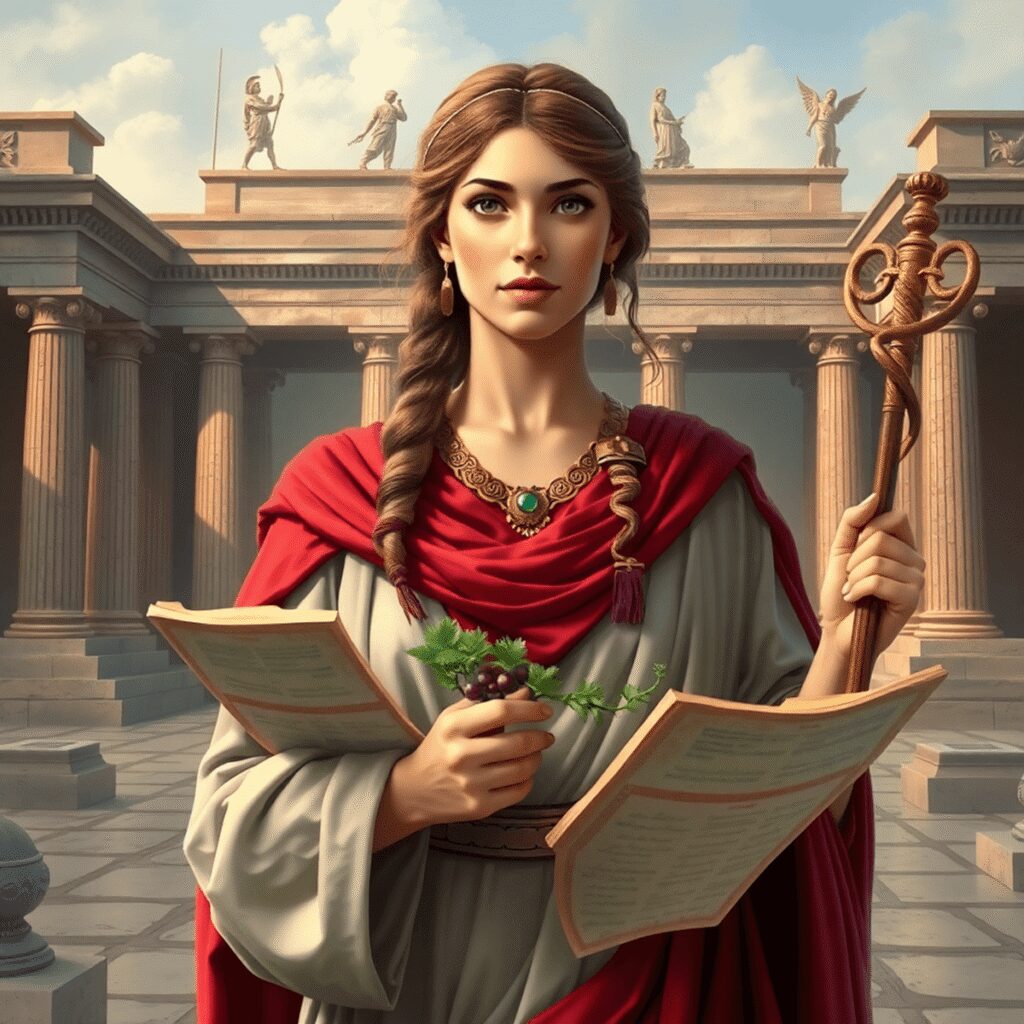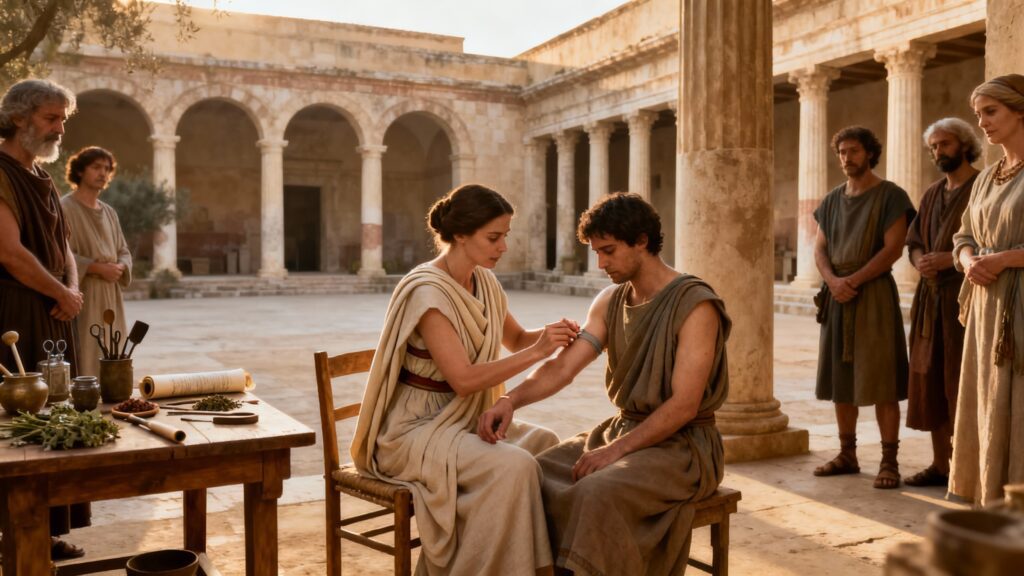The history of medicine in Ancient Rome is often told through the achievements of male physicians and scholars. This view misses an important group that played a significant role in medical practice—women doctors in Ancient Rome. These female physicians went against societal expectations, challenging the strict gender barrier that medicine imposed. Their stories reveal a part of Roman medical history where women were not just patients or caregivers but also active practitioners and innovators.
Understanding the role of women doctors in Ancient Rome provides insight into how gender affected access to medical knowledge and professional opportunities. Despite being in a field dominated by men, these women found ways to overcome social limitations and provide healthcare, develop expertise, and sometimes gain public recognition for their work.
This article explores how these pioneering women shaped medicine in Ancient Rome, challenging gender norms and enriching our understanding of both medical history and gender dynamics.
The Medical Landscape of Ancient Rome
Ancient Roman medicine was a field overwhelmingly dominated by men, both in practice and in authorship of medical literature. The prevailing medical knowledge came from male physicians whose works shaped the understanding and treatment of disease. These male figures not only practiced medicine but also authored influential texts that guided medical theory and practice for centuries.
Key Contributors to Medical Thought in Ancient Rome
Key figures such as Aristotle, Herophilus, Soranus, Aretaeus, and Galen stand out as major contributors to medical thought in Ancient Rome. Their writings formed the backbone of Roman medical education and practice:
- Aristotle contributed foundational ideas about anatomy and physiology, though his focus remained philosophical.
- Herophilus pioneered early anatomical studies based on human dissections.
- Soranus specialized in gynecology but still framed women’s health within a male-oriented perspective.
- Aretaeus wrote extensively on diseases, often emphasizing humoral imbalances.
- Galen became one of the most influential physicians, whose theories on anatomy, physiology, and therapeutics persisted into the Renaissance.
The Influence of Male Perspectives on Medical Texts
These medical authorities produced texts largely from a male point of view. The Hippocratic Corpus, which influenced Roman medicine heavily, contains treatises on women’s health issues but interprets them through patriarchal assumptions about female biology. For example:
- Women’s bodies were seen as weaker or less perfect than men’s.
- Menstruation was believed to be necessary for health; its absence was often viewed as dangerous or pathological.
- Treatments for conditions like hysteria involved symbolic or ritual practices rather than scientific inquiry.
This male-centered framework limited the scope of understanding regarding women’s health conditions. Women’s unique physiological experiences were often misunderstood or dismissed, resulting in treatments that focused more on controlling female bodies than on healing them effectively.
Biases in Medical Practices
Medical practices reflected these biases. Most therapeutic approaches were designed by men for men, with little room for acknowledging women’s perspectives or expertise. Inscriptions and surviving texts rarely mention women as practitioners or contributors to medical knowledge, reinforcing their marginalization.
The dominance of male authorship shaped Ancient Roman medicine into an institution where women’s roles were minimized within official discourse—even though women did contribute informally through caregiving and alternative healing methods. Furthermore, this male-dominated medical landscape was interwoven with the broader societal structures established during Ancient Rome which have left a lasting impact on various aspects of modern life including legal systems as highlighted in this article about the enduring legacy of Roman law. Additionally, the spiritual practices of the Romans which included rituals and sacrifices, further reflect the complexities of their societal norms and beliefs during that era.

Women Practicing Medicine in Ancient Rome
Women faced significant barriers in Ancient Rome when it came to formal education and official entry into the medical profession. Despite these challenges, female doctors in Ancient Rome, often referred to as medicae, found ways to practice medicine and make meaningful contributions to healthcare.
Roles and Pathways into Medicine
- Freedwomen: These individuals often became important healthcare providers. Their status allowed them some autonomy, enabling them to acquire and apply medical knowledge within their communities.
- Relationships with male physicians: Many women gained medical skills through their connections with male doctors, particularly as wives or daughters. These relationships provided informal training and access to medical practices that were otherwise restricted by societal norms.
- Independent practice: Some women operated on their own, using a combination of learned knowledge and traditional remedies passed down through generations.
Medical Knowledge and Skills
The expertise of women medical practitioners blended several elements:
- Traditional healing methods: Herbal remedies, midwifery, and folk medicine formed the backbone of many women’s approaches to treatment.
- Practical experience: Hands-on care for family members and local populations helped refine their skills.
- Exposure to male medical theories was possible through direct interaction with male doctors or study of texts when accessible, though this was limited.
These women often addressed health issues overlooked by the male-centered medical establishment. Their work included treating gynecological conditions, childbirth assistance, wound care, and managing chronic illnesses. The integration of empirical knowledge with inherited traditional practices created a distinctive female contribution to Roman medicine.
Epigraphic evidence confirms their presence as recognized healers despite the absence of formal accreditation. Inscriptions honor women labeled explicitly as medicae, highlighting their respected role even within a patriarchal society.
The persistence of these women doctors shaped a parallel medical tradition that complemented mainstream Roman medicine. Their involvement challenges assumptions about passive female roles in ancient healthcare systems, demonstrating active participation and expertise that influenced health outcomes within the Roman Empire.
For a more comprehensive understanding of the subject, you can refer to this detailed study which delves into the various aspects of women’s roles in ancient Roman medicine. Additionally, this research paper provides further insights into the historical context and significance of these women practitioners. Lastly, another academic article explores the empirical knowledge and traditional practices that shaped their contributions to medicine.
Notable Women Doctors and Their Contributions to Medicine
Several women in Ancient Rome distinguished themselves as skilled medical practitioners, challenging the male-dominated medical hierarchy through their expertise and dedication. Their legacies provide valuable insight into the practice of medicine by women despite societal limitations.
Sarmana: The Long-Lived Doctor of Rome
Sarmana doctor Rome stands out for her remarkable longevity and medical prowess. Historical inscriptions note that she lived to about 70 years old, an impressive age for the era, likely reflecting both her personal health practices and professional knowledge. Sarmana’s career exemplifies how women could sustain long-term involvement in healing arts, gaining respect within their communities by blending empirical experience with traditional remedies.
Naevia Clara: Physician and Medical Scholar
Naevia Clara physician carved a unique niche by coupling practical medicine with scholarly contributions. Unlike many female practitioners who remained anonymous or unrecorded, Naevia Clara’s work went beyond treating patients—she engaged with medical theory and documentation. Her dual role as healer and intellectual suggests that some women not only practiced medicine but also contributed to its evolving body of knowledge, challenging the perception that medical scholarship was exclusively male territory.
Julia Saturnina: Medicae and Supporter of Medical Practice
Known as Julia Saturnina medicae, she was both a competent doctor and an essential collaborator in her husband’s medical practice. Her involvement highlights how marriage sometimes served as a platform for women to participate indirectly in formal medical settings. Julia’s skills extended beyond basic care; she played an active role in diagnosis and treatment, effectively bridging domestic support and professional practice.
Terentia of Nicaea: The Renowned Healer
Terentia Nicaea healer gained recognition for her proficiency in addressing various ailments, making her a sought-after practitioner. Her reputation is preserved through inscriptions emphasizing her healing abilities rather than mere association with male relatives or patrons. Terentia’s example confirms that women could independently establish themselves as respected healers, contributing to public health beyond gender expectations.
These profiles illustrate a spectrum of involvement—from direct medical practice to scholarly activity—by women doctors in Ancient Rome. Their stories enrich our understanding of how female healers operated within and sometimes transcended the constraints imposed by ancient society.
The backdrop of these women’s achievements is the vast Roman Empire, which was not just known for its cultural and architectural advancements but also for its formidable military strength. The Roman military was a well-oiled apparatus that combined discipline, strategy, and innovation, reflecting the empire’s vastness and diversity.
Additionally, the societal structure they navigated was heavily influenced by the Roman Pantheon, a diverse collection of gods and goddesses worshipped in ancient Rome. This pantheon reflected the values, beliefs, and customs that influenced the lives of its people, including those of our notable women doctors.

Breaking Gender Barriers: The Societal Impact and Legacy of Women Doctors in Ancient Rome
Women doctors in Ancient Rome directly challenged the rigid gender roles that medicine had long enforced. Practicing medicine in a male-dominated society defied expectations that limited women to domestic or auxiliary roles. These female practitioners demonstrated expertise, skill, and authority equal to their male counterparts, quietly reshaping the perception of women’s capacities within professional spheres.
Evidence of Female Recognition in Roman Medicine
Inscriptions and monuments provide tangible proof of female recognition in Roman medicine. Public honors, funerary epitaphs, and dedicatory statues commemorate women like Sarmana and Naevia Clara not only as healers but as respected figures in their communities. One inscription describes Julia Saturnina with titles emphasizing both her medical skill and social status, suggesting these women were acknowledged publicly for their contributions rather than relegated to obscurity.
Challenging Assumptions about Women’s Roles
This recognition challenges assumptions about women’s invisibility in ancient professional life. The presence of women doctors implies broader possibilities for female participation beyond medicine—encouraging historians to reconsider women’s roles across various crafts, trades, and intellectual fields in Ancient Rome.
Societal Impact Beyond Healthcare
Moreover, the societal impact of these women extends beyond the realm of healthcare. Their influence can be seen reflected in various forms of cultural expression such as Roman sculpture, which evolved significantly over time to showcase a distinct focus on realism and the portrayal of power. These sculptures served not only as artistic expressions but also as instruments for political propaganda and religious devotion.
Additionally, the use of coins as propaganda during this period further illustrates how power dynamics were communicated through various mediums. Coins became significant instruments for political messaging, reflecting the authority and legitimacy of emperors while also serving as a means of trade.
Furthermore, the role of images in conveying political messages cannot be overlooked. The [use of images as propaganda] played a crucial part in shaping public perception and reinforcing power structures during this time.
Key takeaways:
- Women actively broke barriers by practicing medicine despite societal restrictions.
- Public inscriptions reflect a degree of respect and acceptance not often attributed to women professionals at the time.
- Their legacy invites a reevaluation of gender norms across other ancient professions, highlighting the complexity of women’s historical agency.
Conclusion
Understanding the legacy of women doctors in Ancient Rome enhances our knowledge of medical history and gender dynamics. These ancient female physicians made significant contributions despite societal constraints, shaping practices and challenging norms. Their impact extends beyond medicine, revealing the complexities of women’s roles in a male-dominated world. Recognizing their stories helps correct historical narratives that often overlook female agency. Celebrating Women Doctors in Ancient Rome: Breaking the Gender Barrier in Medicine invites a deeper appreciation of how these pioneers paved the way for future generations of women in healthcare and professional fields.
However, it’s essential to understand the broader context of their achievements. The political instability and weak leadership during certain periods of Ancient Rome created significant challenges, yet these women persevered. Moreover, the trade and economy in Ancient Rome also played a crucial role in shaping societal structures, influencing not only daily life but also the opportunities available to women, including those in the medical field.
FAQs (Frequently Asked Questions)
Who were some notable women doctors in Ancient Rome and what were their contributions?
Notable women doctors in Ancient Rome include Sarmana, known for her extensive medical knowledge and long career; Naevia Clara, a renowned physician who contributed scholarly works to medicine; Julia Saturnina, a skilled medicae who supported her husband’s medical practice; and Terentia of Nicaea, recognized for her expertise in treating various ailments. These women made significant impacts despite societal constraints.
How did women practice medicine in Ancient Rome despite societal restrictions?
Women in Ancient Rome practiced medicine through various avenues such as being freedwomen or wives of male doctors, which allowed them access to medical knowledge. They combined traditional healing methods with insights gained from male counterparts, enabling them to serve as effective healthcare practitioners even without formal education or professional opportunities.
What was the role of gender barriers in shaping the medical field in Ancient Rome?
The medical field in Ancient Rome was predominantly male-dominated, with medical texts and theories largely authored by men like Aristotle and Galen. This male-centric framework limited understanding and recognition of women’s health issues. However, women doctors challenged these gender barriers by contributing significantly to medicine and gaining respect as healers.
How did women doctors in Ancient Rome influence the understanding of women’s health issues?
While the prevailing medical texts focused primarily on male perspectives, women doctors brought attention to women’s health through their practical experience and healing practices. Their involvement helped broaden the scope of medical knowledge to include female-specific ailments, thereby enriching the ancient medical landscape.
What evidence exists that highlights the societal impact and recognition of women doctors in Ancient Rome?
Inscriptions and monuments from Ancient Rome provide evidence of recognition and respect for female healers. These artifacts demonstrate that despite traditional gender roles, women doctors were acknowledged for their expertise and contributions, indicating their significant societal impact beyond just medicine.
Why is it important to acknowledge the legacy of women doctors in Ancient Rome today?
Acknowledging the legacy of women doctors in Ancient Rome is crucial for understanding both medical history and gender dynamics. Their contributions highlight how women broke gender barriers in a male-dominated field, paving the way for future generations and enriching our comprehension of women’s roles in professional fields throughout history.

